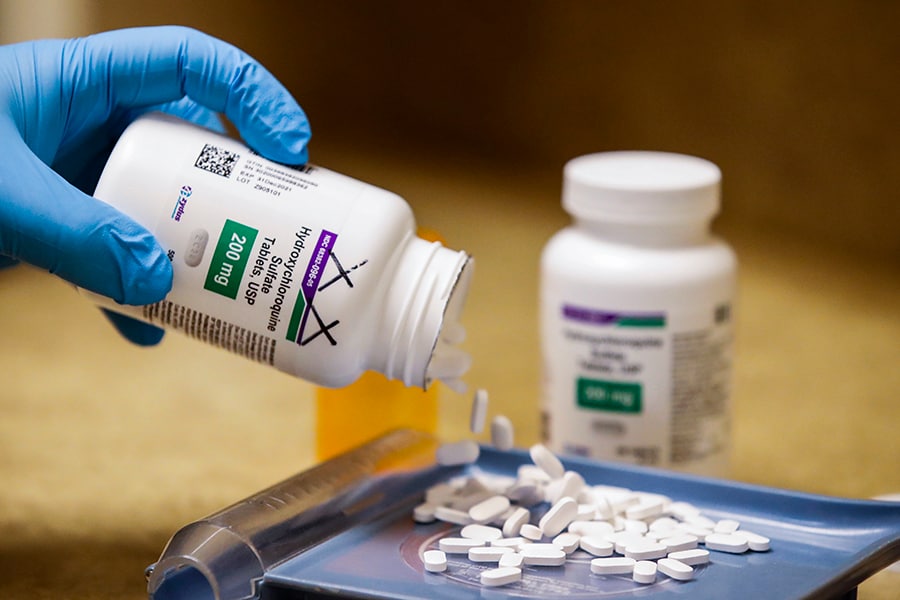Hydroxychloroquine did not prevent Covid-19 infections, study finds
India had lifted its ban on export of the malaria drug, after US President Donald Trump threatened 'retaliation'


 Image: GEORGE FREY/AFP via Getty Images
Image: GEORGE FREY/AFP via Getty Images
The malaria drug hydroxychloroquine did not prevent COVID-19 in a rigorous study of 821 people who had been exposed to patients infected with the virus, researchers from the University of Minnesota and Canada are reporting Wednesday.
The study was the first controlled clinical trial of hydroxychloroquine, a drug that President Donald Trump has repeatedly promoted and recently taken himself. Conducted in the United States and Canada, this trial was the first to test whether the drug could prevent illness in people who have been exposed to the coronavirus. This type of study, in which patients are picked at random to receive either an experimental treatment or a placebo, is considered the most reliable way to measure the safety and effectiveness of a drug. The participants were health care workers and people who had been exposed at home to ill spouses, partners or parents.
“The take-home message for the general public is that if you’re exposed to someone with COVID-19, hydroxychloroquine is not an effective post-exposure, preventive therapy,” the lead author of the study, Dr. David R. Boulware, from the University of Minnesota, said in an interview.
The results are being published in The New England Journal of Medicine.
“If we could find something that would ameliorate infection, block it or make it milder after a solid exposure, that would be quite wonderful,” said Dr. Judith Feinberg, vice chairwoman for research in medicine at West Virginia University. “What we want to do is limit the number of cases. There was great hope riding on this.”
The president’s promotion of the drug, and the backlash against it, have politicized medical questions that would normally have been left to researchers to answer objectively. Trump supporters and opponents have accused one another of twisting facts about the drug to make the president look either right or wrong.
But Trump has not stopped touting the drug’s potential benefits. On Sunday, his administration announced that it was sending 2 million doses of the drug to Brazil, to treat patients and help prevent infection in health care workers. A White House official said the two countries would collaborate on research into its use.
Early in the pandemic, the drug"s use was spurred by anecdotal reports from China and France of patients who seemed to improve and laboratory findings of a possible antiviral effect. With no proven treatment for COVID-19, doctors have been desperate to give severely ill patients some kind of therapy.
Studies in very ill coronavirus patients have linked the drug — especially when combined with the antibiotic azithromycin — to dangerous heart-rhythm disorders, and both the Food and Drug Administration and the National Institute of Allergy and Infectious Diseases have warned that it should not be used outside of clinical trials or carefully monitored conditions in a hospital.
Some researchers say that safety concerns about the drug have been overblown, alarming the public and making it difficult to recruit participants for the studies needed to determine whether the drug has any value for treatment or prevention.
The new study included 821 people from across the United States and parts of Canada who had a either a high-risk or moderate-risk exposure to a person who had tested positive and was ill from the coronavirus. None of the participants had symptoms themselves. High-risk exposure meant they were less than 6 feet from a patient for more than 10 minutes, with neither a mask nor a face shield. Moderate risk meant they wore a mask but no face shield.
About 88% had high-risk exposures.
The participants, recruited online, ranged in age from 33 to 50, with a median age of 40. About half were women, and 66% of the total were health care workers. They were healthy and had no underlying health problems that would have made hydroxychloroquine dangerous for them. Most of the rest had been exposed at home, to an infected spouse, partner or parent.
Within four days of exposure, the participants were picked at random to receive either hydroxychloroquine or a placebo, and then followed to determine whether they had either laboratory-confirmed COVID-19 or an illness consistent with the virus, during the next 14 days.
The drug or placebos were mailed to them, and they then reported their symptoms online to the researchers, who did not examine them.
Not all the participants could be tested for the virus because when the study was being conducted, there was still a shortage of test kits.
There was no meaningful difference between the placebo group and those who took the drug. Among those taking hydroxychloroquine, 49 of 414, or 11.8%, became ill. In the placebo group, 58 or 407, or 14.3%, became ill. Analyzed statistically, the difference between those rates was not significant.
The drug also did not make the illness any less severe.
Side effects like nausea from hydroxychloroquine were more common than from placebos, 40.1% compared with 16.8%, but there were no problems with heart rhythm or any other serious adverse effects.
Infectious disease experts who were not part of the study said it was well done and answered an important question, though the results were disappointing.
Dr. William Schaffner, an infectious disease specialist at Vanderbilt University, said: “This was a large, randomized controlled trial done by very good people. Hydroxychloroquine did not provide a notable advantage.”
First Published: Jun 04, 2020, 10:44
Subscribe Now